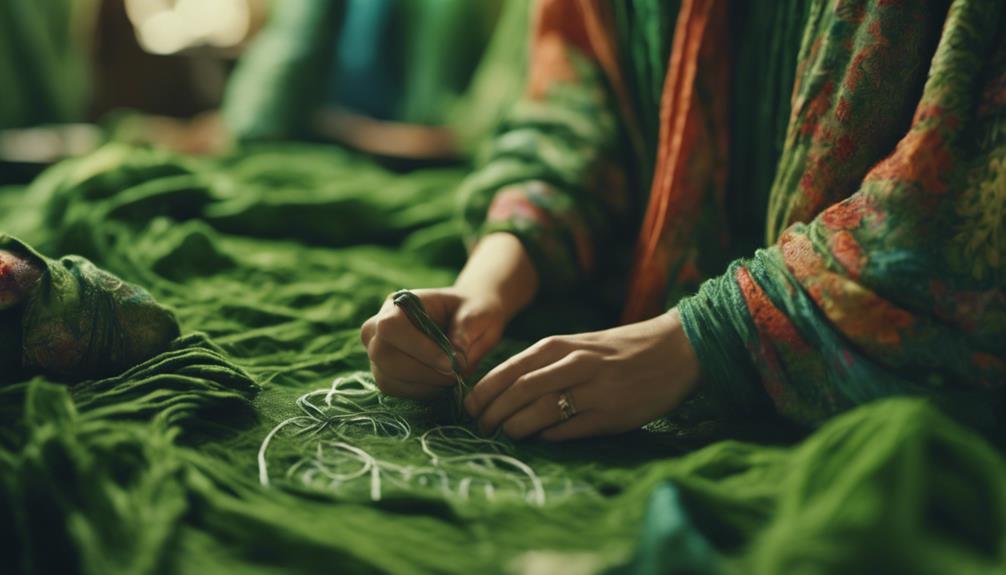The goal of sustainable fashion is to help create a better environment by reducing environmental damage and promoting ethical labor practices. This involves using eco-friendly materials such as organic cotton and recycled fabrics to decrease pollution and resource depletion. Sustainable fashion also advocates for fair wages and humane working conditions for garment workers, ensuring their rights are protected. Instead of endorsing harmful fast fashion, sustainable fashion promotes mindful consumption and recycling. If you’re interested in learning more about how this affects your purchasing decisions and the industry overall, there are plenty of fascinating insights to discover.
Key Takeaways
- Sustainable fashion aims to reduce environmental impact by utilizing eco-friendly materials and ethical labor practices.
- It promotes the use of organic fabrics, minimizing pollution and water consumption in clothing production.
- The movement encourages mindful consumption, shifting away from harmful fast fashion practices that exploit workers and harm the planet.
- Ethical practices in sustainable fashion ensure fair labor standards, providing living wages and humane working conditions for garment workers.
Understanding Sustainable Fashion
Sustainable fashion seeks to reduce the environmental impact of clothing by promoting eco-friendly materials and ethical labor practices throughout its lifecycle. It emphasizes the use of organic fabrics like cotton and hemp, which minimize water consumption and pollution compared to traditional materials. By choosing these biodegradable options, you're supporting a shift away from the harmful practices associated with fast fashion.
Understanding ethical fashion is essential, too. This approach guarantees fair wages and safe working conditions for garment workers, addressing the exploitation that often occurs in the industry. With a growing awareness among consumers, there's a rising demand for transparency from brands. Many people, including you, are keen to know where their clothes come from and how they're made.
As a result, 66% of consumers are willing to pay a premium for brands committed to sustainable practices. This increased consumer awareness drives the fashion industry towards eco-friendly practices, fostering a culture that values both the planet and its workers.
Importance of Ethical Practices

When you choose sustainable fashion, you support fair labor standards that guarantee workers receive fair wages and work in safe conditions.
Transparency in sourcing lets you understand where your clothes come from, helping you make informed choices.
Fair Labor Standards
Fair labor standards are essential for ensuring garment workers receive fair compensation and humane treatment in an industry often plagued by exploitation. Many fast fashion brands neglect these standards, paying workers as little as $80 a month, while ethical fashion brands prioritize fair labor practices by providing living wages that meet workers' basic needs. This commitment to sustainable fashion helps combat social injustices and promotes better working conditions.
Here's a quick comparison to illustrate the impact:
| Aspect | Fast Fashion | Ethical Fashion Brands |
|---|---|---|
| Minimum Wage | $80/month | Living wages |
| Working Conditions | Unsafe and unregulated | Safe and humane |
| Transparency in Supply Chains | Lacking | High transparency |
| Treatment of Workers | Often exploitative | Dignified and respectful |
| Consumer Awareness | Low | Increasing |
Transparency in Sourcing
Transparency in sourcing plays an essential role in fostering ethical practices within the fashion industry by allowing consumers to understand the origins and production methods of their clothing.
By knowing where and how their garments are made, you empower yourself to make informed choices. Sustainable brands often disclose details about their supply chains, highlighting their commitment to fair labor practices and responsible sourcing. This level of transparency not only builds trust but also enhances accountability.
As consumer awareness grows, so does the demand for ethical practices. Many of you are willing to pay more for products from brands that prioritize transparency, as a 2020 survey shows that 73% of consumers support this.
Organizations like the Ethical Trade Initiative help set guidelines to guarantee that companies adhere to fair labor practices, reducing the risks of modern slavery and environmental harm.
Environmental Impact Overview

The fashion industry considerably damages the environment, standing as the second-largest global polluter and contributing to a staggering 10% of annual greenhouse gas emissions. Without a shift towards sustainable fashion, this could rise to 25% by 2030.
The environmental impact is profound, and it's essential for you to understand the key issues at play:
- Water Usage: Producing one T-shirt from conventional cotton consumes about 2,700 liters of water, while organic cotton only requires 250 liters.
- Pollution: The industry is responsible for 20% of global industrial water pollution, largely due to harmful chemicals in textile production.
- Microplastic Pollution: Most clothing is made from plastic fibers, leading to significant microplastic pollution in oceans and waterways.
- Waste Reduction: Sustainable fashion practices emphasize recycling, upcycling, and thrifting to minimize waste.
Key Areas of Sustainable Fashion

Sustainable fashion encompasses various key areas that not only prioritize environmental conservation but also promote ethical practices within the industry.
One significant area is ethical fashion, which focuses on fair labor practices and humane working conditions. Many sustainable fashion brands adhere to Fair Trade principles, ensuring workers receive fair wages and safe environments.
Circular fashion is another essential aspect, emphasizing recycling, upcycling, and thrifting to extend the life of products and reduce textile waste. By choosing to buy second-hand or recycled items, you contribute to minimizing the massive waste produced by the fashion industry.
Additionally, slow fashion plays a fundamental role, encouraging you to invest in high-quality, durable items instead of succumbing to fast fashion's rapid turnover. This approach fosters a deeper appreciation for what you wear, promoting mindful consumption.
Transitioning to Sustainable Practices

Shifting to sustainable practices means you need to commit to real changes that go beyond just talking the talk.
By collaborating with manufacturers and distributors, you can tackle the challenges that come with this change.
Actionable Sustainability Commitment
Committing to sustainability means taking actionable steps that foster real change in the fashion industry. It's not just about catchy slogans; it's about embedding sustainable practices into every aspect of your operation.
Here are four key actions you can take:
- Ethical Sourcing: Focus on sourcing materials that are environmentally friendly and ethically produced. This helps guarantee your products have a reduced impact on the environment.
- Eco-Friendly Packaging: Shift to sustainable packaging solutions that minimize waste and are recyclable. This small change can greatly enhance your brand's sustainability profile.
- Collaborate with Stakeholders: Work closely with manufacturers and distributors to share responsibility for sustainable outcomes. Collaboration can lead to innovative solutions that drive progress.
- Educate Consumers: Engage your customers by informing them about your sustainable commitment. Research shows that 66% of consumers are willing to pay more for sustainable brands, making transparency essential.
Collaboration for Change
Collaboration among fashion brands can drive meaningful change, making it easier to adopt sustainable practices across the industry. By joining forces, companies can enhance their environmental, social, and governance (ESG) sustainability efforts, promoting collective action toward a more responsible fashion industry.
When you work together with clients, manufacturers, and distributors, you streamline the shift to sustainability, tackling challenges while maximizing growth potential. This shift often demands innovative business models, which are more effectively developed through partnerships along the supply chain.
By engaging in collaborative efforts, you gain access to shared resources and expertise, facilitating the integration of ethical practices from design to packaging. With research showing that 66% of consumers are willing to pay more for sustainable brands, the market potential for businesses prioritizing collaboration in sustainability is significant.
As you pursue these collaborative initiatives, you not only reduce your environmental impact but also pave the way for a more sustainable future in the fashion industry. Embracing collaboration is the key to driving responsible change, ensuring that sustainability becomes an integral part of your business strategy.
Overcoming Transition Challenges
How can you effectively navigate the challenges of adopting sustainable practices in your fashion business? Shifting to sustainable fashion requires strategic approaches to overcome obstacles like higher costs and consumer resistance. Here are four key steps to guide you:
- Embrace Ethical Sourcing: Start by prioritizing ethical sourcing and eco-friendly production methods. While the initial costs might impact profit margins, the long-term benefits can outweigh these challenges.
- Foster Collaboration: Engage in collaboration with clients, manufacturers, and distributors. Strong partnerships can enhance transparency in your supply chain, making it easier to implement sustainable practices.
- Leverage Market Incentive: Take note that 66% of consumers are willing to pay more for sustainable options. This consumer willingness acts as a significant market incentive, encouraging you to adapt your offerings.
- Utilize Available Resources: Don't hesitate to seek out resources designed to help brands navigate the complexities of sustainable shifts. These can cover everything from ethical considerations to eco-friendly packaging solutions.
The Role of Consumer Awareness

Consumer awareness greatly influences the demand for sustainable fashion, with many people enthusiastic to invest in ethically produced items. When you understand the environmental impacts of the fashion industry, it pushes you toward eco-friendly alternatives. Did you know that 66% of consumers are willing to pay more for sustainable products? Social media plays an essential role in this awareness, as influencers highlight sustainable brands and practices, thereby encouraging responsible purchasing.
By grasping the true cost of fast fashion—including pollution and unethical labor practices—you empower yourself to make informed choices. Consumers increasingly demand transparency in supply chains, which prompts brands to adopt sustainable practices.
Here's a quick comparison to illustrate the impact of consumer choices:
| Consumer Action | Impact on Fashion Industry |
|---|---|
| Support sustainable brands | Encourages ethical production |
| Demand transparency | Promotes responsible practices |
| Share on social media | Raises awareness and drives change |
Practical Tips for Sustainable Shopping

When you're shopping for clothes, making mindful choices can greatly reduce your environmental impact and support sustainable practices. Here are some practical tips to help you embrace sustainable fashion:
- Research Brands: Before purchasing, check for ethical transparency in a brand's practices. Look for those that prioritize fair employee treatment and environmental responsibility.
- Choose Timeless Designs: Opt for classic styles that resist fleeting trends. This approach reduces clothing turnover and waste, allowing you to build a more sustainable wardrobe.
- Support Local Economies: Whenever possible, buy locally produced items. This not only lowers emissions from shipping but also fosters community sustainability by supporting local businesses.
- Select Recycled Materials: Look for clothing made from recycled fibers. These materials minimize landfill waste and lessen the reliance on new resources, contributing to a circular economy.
Don't forget to reflect on donating unused clothing instead of discarding it. This practice encourages reuse and extends the lifecycle of garments, further supporting sustainable fashion.
Benefits of Sustainable Fashion

Sustainable fashion offers numerous benefits that positively impact both the environment and society, making it a smart choice for mindful consumers. By embracing sustainable fashion, you contribute to significant environmental outcomes, including pollution reduction and waste reduction. This approach encourages you to prioritize quality over quantity, leading to investments in longer-lasting clothing instead of fast fashion items that quickly end up in landfills.
When you support sustainable brands, you're also endorsing fair labor practices, which promote safe working conditions and fair wages for workers. This commitment to social equity enhances the entire fashion industry's integrity. Additionally, sustainable fashion often incorporates recycled materials, which reduces the demand for virgin resources. For example, using recycled polyester can save thousands of barrels of oil, benefiting the planet.
Moreover, sustainable fashion fosters community engagement, inviting you to participate in initiatives focused on recycling, upcycling, and responsible consumption. By choosing sustainable options, you not only enhance your wardrobe but also become part of a larger movement aimed at creating a more equitable and environmentally friendly world. These sustainable fashion key factors empower individuals to make informed choices that align with their values, promoting transparency and ethical practices within the industry. Supporting brands that prioritize fair wages, eco-friendly materials, and reduced waste amplifies the collective impact of these efforts. Together, these actions contribute to a paradigm shift, proving that style and sustainability can go hand in hand.
Embrace these benefits and make a positive impact through your fashion choices!
Future of the Fashion Industry

The future of the fashion industry hinges on embracing sustainability, as brands adapt to meet rising consumer demands for transparency and ethical practices.
You'll see a significant shift as companies prioritize their environmental impact and focus on long-term success. Here are four key trends shaping this transformation:
- Innovative Materials: Expect brands to increasingly adopt biodegradable fabrics and recycled fibers, minimizing waste and reducing reliance on virgin resources.
- Transparency: Consumers are demanding clearer information about product origins and manufacturing processes, pushing brands to disclose their sustainability efforts.
- ESG Practices: The integration of environmental, social, and governance (ESG) practices will become a standard, enhancing the accountability of fashion companies.
- Regulatory Changes: Upcoming regulations will compel brands to adopt sustainable practices, ensuring they remain competitive in this evolving market.
As the fashion industry continues to evolve, staying ahead of these trends will be essential for brands.
Frequently Asked Questions
What Is the Purpose of Sustainable Fashion?
Sustainable fashion aims to reduce environmental damage and promote ethical labor practices. It encourages you to make conscious choices, supporting eco-friendly materials and practices that extend clothing life, ultimately leading to a more responsible fashion industry.
Why Is Sustainable Fashion Important for the Future?
Sustainable fashion's like a lifeboat in a stormy sea; it's essential for our future. By choosing ethical, eco-friendly options, you help reduce pollution and support a fairer industry, ensuring a healthier planet for generations to come. In addition to protecting the environment, ecofriendly fashion benefits also extend to the well-being of garment workers. By supporting ethical and sustainable fashion brands, you are contributing to better working conditions and fair wages for the people who make the clothes we wear. Furthermore, embracing sustainable fashion encourages innovation and creativity in the industry, leading to a more diverse and vibrant market for eco-friendly options.
What Does Sustainability Mean to You in Fashion?
Sustainability in fashion means you prioritize eco-friendly materials, ethical production, and mindful consumption. It's about reducing waste, supporting fair labor practices, and valuing quality over quantity, ensuring your choices benefit both people and the planet.
What Is Sustainable Fashion and Why Should We Care?
Imagine a world where your clothes don't harm the planet. Sustainable fashion's about making choices that protect our environment and support fair labor, so you can wear your values proudly while enjoying stylish, durable pieces.
Conclusion
In the garden of fashion, sustainable choices are the seeds we plant today for a vibrant tomorrow.
By nurturing ethical practices and being mindful consumers, you cultivate a landscape where creativity flourishes without harming our planet.
As you embrace sustainable fashion, you become a gardener of change, reaping the benefits for yourself and future generations.
Remember, every small step you take can blossom into a movement, transforming the industry into a thriving ecosystem of style and responsibility.









